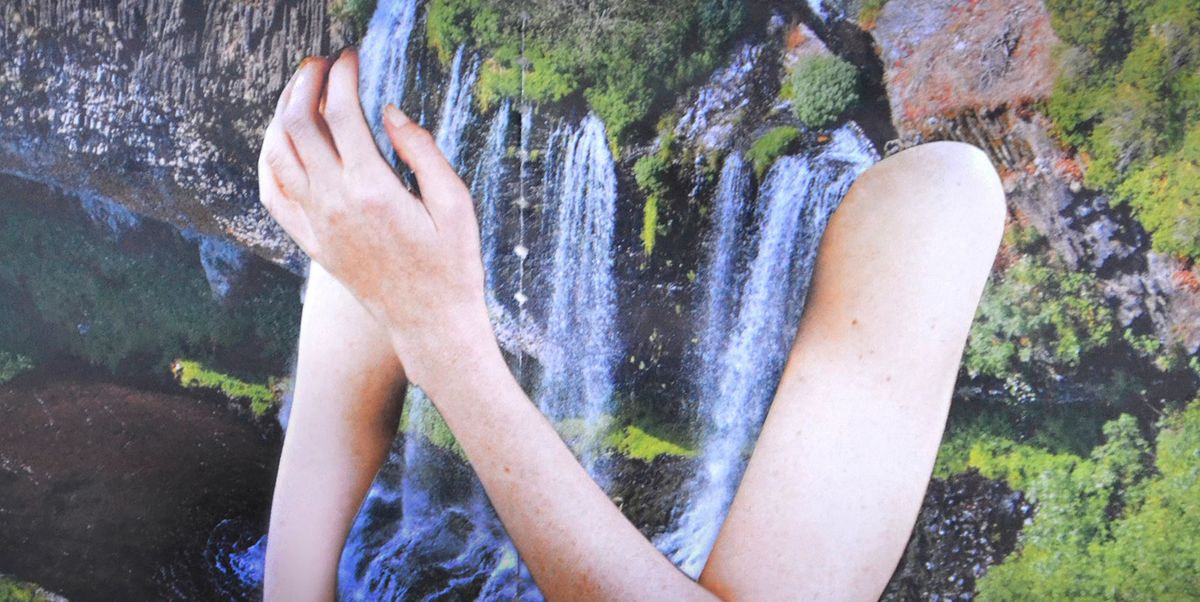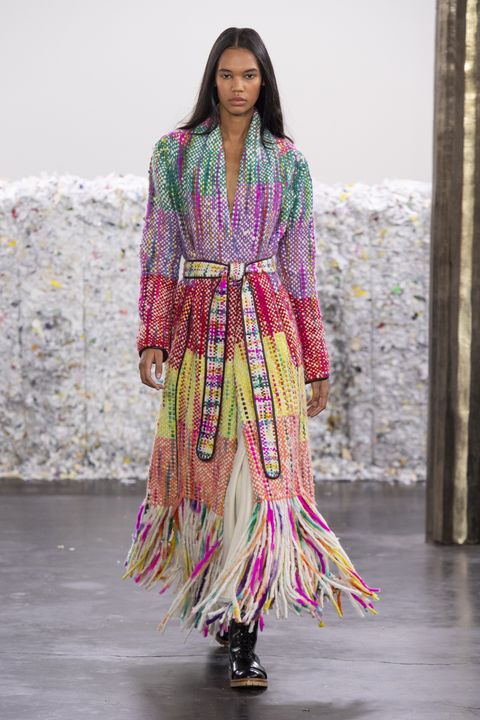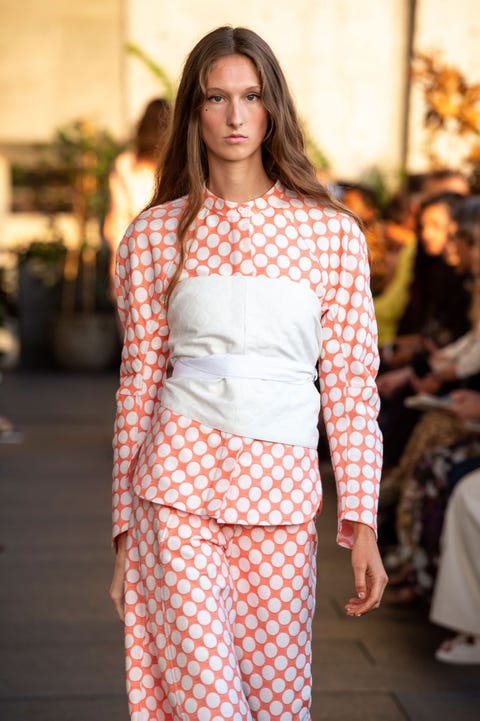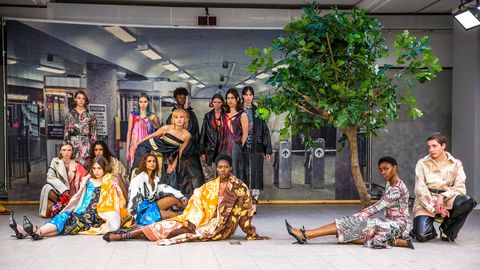Last year, the Swedish Fashion Council made an unprecedented move while planning the annual Stockholm Fashion Week: They canceled the event entirely, citing concerns about its environmental impact. Not everyone in fashion is taking such drastic measures, of course, but it spoke to the urgent need for action on the issue, one that designers and customers alike are now recognizing.
Fashion is responsible for around 10 percent of the world’s carbon emissions and nearly 20 percent of the world’s water waste, according to several United Nations groups. An estimated 85 percent of the world’s textiles end up in landfills or incinerated. Fast fashion no doubt contributes mightily to this waste, but it is by no means alone.
At the G7 summit in August, 32 major fashion companies, including Kering, Chanel, and Inditex (the parent company of Zara), committed to a host of environmental initiatives, agreeing to eliminate single-use plastics by 2030 and to seek out more sustainable sources of raw materials. Gabriela Hearst made headlines when she offset the carbon footprint of her spring 2020 fashion show in New York by limiting transportation energy costs, booking local models, minimizing packaging and energy use, and reducing waste. And after Nordstrom created a mechanism for its customers to shop online for “sustainable style,” customer searches for that category rose by 3,100 percent in 2019.
So has the fashion industry finally shifted from lip-service sustainability to impactful action? Certainly, many are making changes, simultaneously forced and incentivized to do better by socioeconomic forces, from stricter recycling laws to the galvanizing activism of so many young people. In 2019, Kering—owner of Gucci, Balenciaga, Saint Laurent, and other luxury brands—pledged to offset its greenhouse gases by purchasing carbon credits and to commit to full carbon neutrality across the company. LVMH and Burberry are doing the same. Writing checks won’t make the fashion giants truly sustainable, but it is a potent and promising gesture from the industry’s leaders.
One shudders to think of the carbon footprint of red-carpet fashions that are jetted across the world and worn once, if at all. But some stars are shaking up the status quo. Joaquin Phoenix showed up at January’s Golden Globes in an impeccable Stella McCartney tuxedo he promised to rewear throughout awards season. Easier done with a suit than a gown, but the dis to fashion’s wear-it-once ethos was on point. Hollywood stylist Jeanne Yang says several of her clients have requested sustainable options for their red-carpet appearances. At his Aquaman premiere, her client Jason Momoa donned a vintage Tom Ford–era Gucci robe that Yang found on The RealReal. (He slipped it off to dance the haka.) “I try as much as possible not to use fast fashion, even for my kids,” says Yang, who is cooking up a concept for a suit that could be worn three different ways to reduce the need for her clients’ frequent wardrobe changes. It’s now boast-worthy to participate in sharing-economy and reuse enterprises such as Rent the Runway and The RealReal, which posts the gallons of water offset by each customer’s purchase.
It’s heartening, but none of this nears the tidal wave of action required of the industry and the consumers who support it. It may take real discomfort to make the changes necessary in time to avert planetary disaster. And discomfort—unless we’re talking stiletto heels—is rarely embraced by the ease-obsessed fashion industry.
We can all do our part by buying fewer, better clothes. Maria Cornejo, designer of Zero + Maria Cornejo, has been manufacturing in New York and reusing dead-stock and sustainably made materials for years, but her real goal, she says, is to make clothes that people will want to wear for decades. “Make good heirlooms,” she argues. “Nobody buys anything because it’s sustainable. First, it has to be desirable.” That thought is echoed by Erin Lowenberg, creative director of Rothy’s, a footwear company that launched in 2016 with two styles of flats knit from recycled water bottles (Meghan Markle is a fan). Its initial customers may have been more interested in the look and feel of the shoes than their impact on a waste- and leather-intensive industry, but the brand’s environmental cred has surely contributed to its explosive growth (its customer base increased 105 percent from 2018 to 2019, surpassing 1.4 million). It introduced its newest category in March: handbags made from a blend of ocean-bound marine plastic and recycled water bottles.
Solutions must be more than just green, which is why Stephanie Benedetto talks up financial and inventory-management benefits as she makes the case for Queen of Raw, a technology platform she cofounded in 2018 to connect people and brands with leftover fabrics—an estimated 15 percent of every production run. Queen of Raw caters to home sewers as well as big fashion companies, and Benedetto estimates that dead-stock textiles could become a $120 billion business. “It’s insane, the volume that is out there,” says Benedetto, who has listed fabrics up to a million yards long, or as short as a few yards, for a base of over 130,000 clients. “Never doubt you can change the world,” she says. “We will.”
Young brands such as Reformation are finding fans who are equally drawn to their designs and their sustainable efforts. Reformation operates on the borderline of fast fashion, but it offers public tours of its Los Angeles factory to prove the bona fides of its fairly treated workforce and posts photos to its Instagram account of suppliers such as Filpucci, a Tuscan mill that recycles cashmere into new yarn.
It’s doubtful Greta Thunberg intended to become a fashion muse, but she has inspired everything from T-shirts emblazoned with her likeness (possibly the precise impact she opposes) to a full collection by Sweden-based designers Josephine Bergqvist and Livia Schück, founders of the label Rave Review. Their spring 2020 collection was made with only preexisting materials, including upcycled vintage blankets, bedsheets, and tablecloths.
As parts of the world grapple with water shortages, anyone with a heap of denim in their closet might note the terrifying UN statistic that it takes 10,000 liters of water to grow a kilo of cotton—the equivalent of one pair of jeans. Levi Strauss & Co. has updated its climate action plan to reduce its global supply chain’s greenhouse gas emissions by 40 percent by 2025—and by 90 percent in its owned-and-operated facilities. Now consumers need to step up. How many pairs of jeans does someone need—and how often should they be washed?
Perhaps, as with so many eco-friendly shifts—like ditching plastic for glass bottles—change will come not from looking to the future, but to the past. Living sustainably came naturally to our grandparents and great-grandparents, who spot-cleaned, mended their clothing, and maintained minuscule wardrobes by modern standards. The answer may well have been right there all along—in our closets.
Top image: “Cold Feelings” (2012) by Djuno Tomsni.
This article originally appeared in the April 2020 issue of ELLE.



